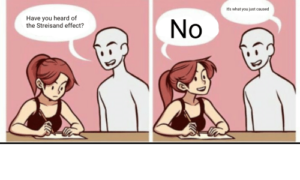This article is co-authored by me and Umang Sethi, a fourth year student from Institute of Law Nirma University, Ahmedabad.
In addition to being infamous for moral rights infraction, the controversy over the song “Genda Phool” by Badshah, illustrates the mystifying nature of the internet. The song was embroiled in several copyright issues mainly arising from the moral rights of the author mentioned under Section 57 of the Copyright Act, 1957. However, the present article discusses it in the context of the Streisand effect of the internet along with the marketing theory of long tail in the copyright regime making a paradoxical effect of “non-attribution” to the unpredicted recognition to the author.
Streisand Effect of “Non-Attribution”
It is not the first time when Ratan Kahar was not given the attribution of his authorship. In 1976 when the song was first performed, he was not given the authorship credits. There are several versions of the songs available on the internet without his mention. However, no controversy gained such unprecedented attention.
In the present case, there appears two probabilities of non-attribution. Either the Panjabi Rockstar deliberately hid the true author’s name or he could not find the author. In either of the situations, the song was hit by the Streisand effect, thereby making the content and creators more famous than they could have been. Relevantly, the Streisand effect occurs when an attempt to hide, remove or censor information has the unintended consequence of further publicizing that information, often via the Internet.
In the current context wherein, it has not only increased the viewership of Badshah’s song but has also revived the career prospects of a poor Bengali artist. After the controversy, many YouTube channels, magazines, blogs, featured the issues thus, enhancing the viewership of the song and the authors. People made videos and writing articles on the life and struggle of Ratan Kahar who almost remained unknown before the controversy. Consequently, Badshah paid 5 lac to Ratan Kahar. Such aid is likely to incentivize him to contribute more to the folk songs and culture, highlighting the incentive theory and welfare theory of IP. Similarly, this has also fructified Badshah’s efforts to bring Indian folk culture to the world market thereby giving them better recognition in the world.
Long Tail Theory: A tool to revamp Copyright law?
The marketing concept of long tail describes internet as an instrument to capitalize in the market and holds substantial relevance in the copyright realm. Simply, it emphasises upon selling of niche/unpopular products than easy to find popular products. Under copyright law, these niche products can be analogised with independent and unappreciated artists who remained left out.
The theory argues that sellers to earn significant profits must sell a lesser quantity of niche or hard to find products than the huge quantity of popularly known goods. These goods can earn considerable amount of profits because consumers nowadays are shifting from mainstream markets. Thus, it highlights the paradoxical shift of consumers from Brick and Mortar/shelf-based marketing to increasing number of online market places like Amazon, Flipkart, YouTube etc. Under copyright domain, there are many niche creators who do not get a recognised platform or huge fan followings and thus, never get exposed to the deserving public. This often occurs to the traditional cultural artists whose talent and intellectual efforts remain confine to a particular area. Resultantly, both public and artists suffer. Ranu Mondal, Shawn Mendes, Chance the Rapper, Justin Bieber etc. are classic examples of such artists who could not come into the market, if internet was not there.
In the symbolic sense, the theory posits that to fructify the objective of copyright law (i.e. to reward creative people and add value to the society), niche artists/works to be exposed to the relevant consumers. On one hand, it satisfies the entertainment and cultural needs of people by exposing them to the unknown and un/less appreciated creators and their work. Conversely, it benefits the creators to gain profit and the deserving acknowledgment in the market.
A Shift from IP Elitization to IP Gentrification?
Before the advent of internet, IP was a primarily matter of elite. There were many socio-political barriers in creating IP. Artiste/authors required sanction of kings or sovereigns in order to create work and get recognition. There were filters which an artiste/author has to use before exerting its intellectual labour. History is filled with examples where people resorted to anonymity and pseudonymity. Clara Schumann and Fanny Mendelssohn are two prime composers who faced discrimination and suppression from their male counterparts. There were people who were legitimately ostracized from IP domain. For instance, in 1975, the patent rights of Sybilla Masters who developed a method to process Indian corn, were given to her husband. Later, she invented another invention for which the accreditation was given to her husband. Likewise, Esther Lederberg did pioneer work in genetics, but the Nobel prize was taken by her husband in his own name. Even today feminist patent scholars are still unheard of. USA history evidences that till 1855, the average patents received per year to a woman in comparison to man were 10-3760. This difference existed because women were made the part of the Food and Fashion industry and men were supposed to handle the domain of science and technology.
Interestingly, Internet has significantly narrowed this gender IP to an extent, if not completely. More specifically, the escalating trend of Social media is playing a crucial role in connecting these artists with the society. Given the increasing access to both mobile phones and internet, it has become considerably easier as well as cost-effective to create work and reach target audience.
Thus, internet, if channelized properly, can obliterate the culture of elite creatorship where creations often remain limited to a particular segment of society for e.g. people associated with music labels or renowned brands. And, it gives impetus to IP gentrification which means IP creation by everyone. Further, it attacks on the corporatization of art where the capitalist’s giants including music labels and production houses beget money under the auspices of copyright law.
Image source: here


















